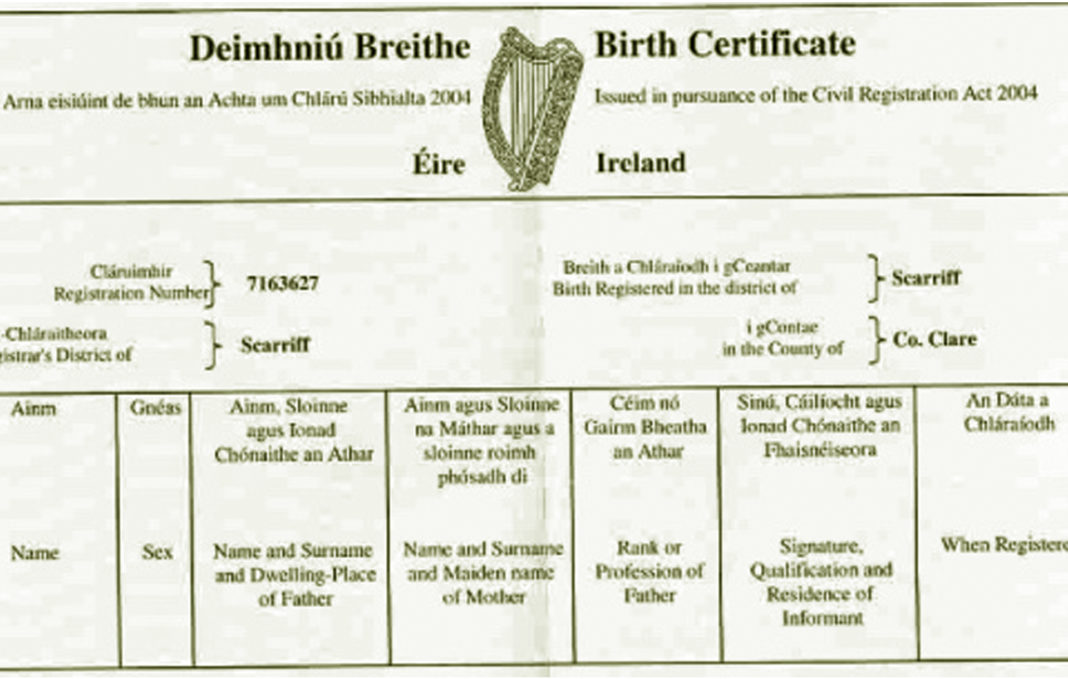I kept wondering last week if I was the only person in Ireland who had seen Stephen Frears’ 2013 Oscar-nominated comedy-drama ‘Philomena’, writes Donal O’Keeffe.
Last week, the child and family agency Tusla revealed that – between 1946 and 1969 – 126 people were incorrectly registered at birth by the former adoption society St Patrick’s Guild. Of the 126 people, 79 may be “entirely unaware of the true circumstances of their birth”.
In short, babies who were adopted illegally were registered on their birth certificates as the birth children of the people adopting them.
Minister for Children, Katherine Zappone – whose full title might as well be Minister for Very Reluctantly Announcing Inquiries into The Really Heinous Stuff Official Ireland and The Catholic Church Would Much Prefer Stay Buried – said Tusla will be attempting to contact the 126 people involved, as “people have the right to know who they are”.
I spent the week wondering how anyone can pretend to be surprised by this development.
I mean, is it possible this is the first time you’ve heard about Ireland’s shameful history of forced adoptions? I suppose it’s entirely possible that you don’t read the Irish Examiner, or you somehow managed to miss Conall Ó Fátharta’s tireless reporting since 2010 on the issue of forced adoption.
The Taoiseach described the scandal of illegal adoption registration as ‘another dark chapter in the country’s history’. This prompted Karl Brophy to tweet “I’ve read Cormac McCarthy novels with fewer dark chapters than Ireland seems to have”.
When Sinn Fein leader Mary Lou McDonald asked if St Patrick’s Guild was ‘the tip of the iceberg’, Taoiseach Leo Varadkar conceded that an investigation of the records of all of the adoption societies is “potentially a mammoth task”.
In what seemed to me a strange note, the Taoiseach added that ‘what’s different’ now is that this is the first time we have ‘documentary evidence’ of forced adoption. This is interesting, not least because Conall Ó Fátharta has been reporting documented cases of forced adoption for eight years now.
In fact, to paraphrase author Anne Enright, Ó Fátharta keeps having to break the same story over and over again.
Maybe it’s possible too to have tuned out the finer details of the Tuam Babies story. Maybe you stopped paying attention once the shock subsided, after Alison O’Reilly’s revelation that 796 babies from the Tuam Mother and Baby Home were unaccounted for and there was a good chance many of them were dumped in a disused Victorian sewerage system.
Maybe you also missed Philip Boucher-Hayes’ follow-up with Catherine Corless on Liveline, and perhaps you overlooked the poignant detail that the woman who caused the entire Tuam Babies scandal to come to light, Anna Corrigan, believes that at least one of her two brothers may actually be still alive and living in North America.
Maybe you haven’t read Alison O’Reilly’s best-selling book My Name Is Bridget. It tells the story of the Tuam Babies, and of Anna Corrigan’s mother, Bridget Dolan. It’s a beautifully-written book that tells a horrible story without ever losing sight of the humanity of those so brutally mistreated by Church and State.
Maybe you didn’t read Mike Milotte’s groundbreaking 1997 book Banished Babies: The Secret History of Ireland’s Baby Export Business, either. Milotte says forced adoption is a crime as old as the State, and provides documentary evidence dating back at least 60 years.
Milotte notes that in June 1954, “a highly confidential memo from the American embassy in Dublin first put the Irish State on notice (of) a serious criminal enterprise involving falsified birth records … What alerted the embassy to the issue was the sudden and unexplained rise in the number of American women claiming to have given birth in Dublin and seeking to have the babies entered on their passports.
“The embassy told the Irish authorities they suspected that the Americans, who had registered the children as their own on the official birth records, ‘are not the mothers of the children, but obtained them from the real mothers’.”
As usual in Ireland, we only pay attention to what’s going on under our noses when the neighbours start looking in the windows. The Tuam Babies story had to make the Washington Post before Official Ireland got upset about it. It was only when the Yanks started sniffing around our adoption scam that we got the Garda Síochána involved.
The resulting investigation established that Mrs Mary Keating of St Rita’s private nursing home in Ranelagh, was falsely registering babies as the natural children of the couples who acquired them from their actual mothers. Mrs Keating didn’t get so much as a caution. Why should she, when she was only one of dozens trafficking children out of Holy Catholic Ireland?
A decade on, the Americans were asking questions again. This time, the Garda Síochána launched an investigation focussing on a prominent figure in public life suspected of being the ‘Mr Big’ orchestrating countless illegal adoptions in Ireland.
A file was prepared for the DPP, who decided to prosecute, not Mr Big, but Mrs Keating.
In the Dublin District Court in January 1965, Mrs Keating pleaded guilty to falsifying the official birth register and procuring bogus birth certificates. The judge described this as ‘a very grave offence’, but she was given the benefit of the Probation Act and allowed to keep her licence. And that was the end of that. Because she had pleaded guilty, no Garda evidence was presented in court, and not a whisper about Mr Big.
Milotte also recounts an anecdotal statement attributed to Charles Haughey that “half the children born at St Rita’s were fathered by members of the Dáil.”
Milotte calls this: “A gross exaggeration, no doubt, but a timely reminder that for every crisis pregnancy there was a putative father in the wings, often men in positions of authority, employers, respectable members of society, other women’s husbands, priests even, and, yes, politicians – all of them equally protected from disclosure by the practice of falsifying birth records.”
Maybe you didn’t read John Banville’s Quirke books, where he explores the stifling 1950s Ireland of political corruption, Church control, sexual hypocrisy, Magdalene Laundries and forced adoptions. It’s all laid out there, the awkward complexities of history boiled down for the simple and truthful purposes of fiction. The nuns, the priests, the curtain-twitching, lay Catholic activists, the politicians, the judiciary, the Archbishop. Women – and girls – pregnant out of wedlock, imprisoned and enslaved in Magdalene Laundries and Mother and Baby Homes, their babies taken from them and sold to wealthy American Catholics. They’re great, those books, even if Banville does write them under the pseudonym Benjamin Black, so he can craft page-turner thrillers and at the same time be snooty about it.
Maybe you missed out too on all of the work of real heroes like Claire McGettrick and Susan Lohan, co-founders of the Adoption Rights Alliance. They estimate that there may have been between 10,000 and 15,000 illegal adoptions, and they say that for all of the talk that we have said goodbye to ‘Old Ireland’, for adopted people and natural parents, ‘Old Ireland still exists’.
Maybe you missed all of that. But come on. You must have seen ‘Philomena‘. Now, I know Leo is more a ‘Love, Actually’ man, but surely he saw ‘Philomena’.
It’s a wonderful film, based on Martin Sixsmith’s 2009 book The Lost Child of Philomena Lee, starring Judi Dench as Philomena Lee and Steve Coogan as Sixsmith.
The film recounts, in dramatised form, the story of Lee’s search for her son, Anthony. Anthony was born in Sean Ross Abbey Mother and Baby Home in Roscrea in 1952 and taken from Philomena for adoption to a wealthy American family.
Anthony became Michael A. Hess, and in time, he would become a respected lawyer and advisor to Presidents Reagan and George HW Bush.
Hess made three visits to Ireland, begging the nuns in vain for help locating his mother. He died in 1995 from complications from AIDS, and was buried at Sean Ross Abbey. He died without knowing that his mother had never given up her search for him.
The film is heart-warming, and heartbreaking, and it balances perfectly Sixsmith’s frustration and moral outrage, and the extraordinary compassion and forgiveness personified by Philomena Lee.
Hess’s partner for the last 15 years of his life was Steve Dahllof. Dahllof rated The Lost Child of Philomena Lee “about a three out of 10, in terms of accuracy”, while the film ‘Philomena’, he said, “in accuracy of spirit, is 10 out of 10.”
We all saw ‘Philomena’. We all read the papers. We all watch the News. We all know about illegal adoptions.
The Ireland of nod and wink, of “If I was going there, I wouldn’t start here”, of “Sure you know yourself” has to end.
Ireland has always known about illegal adoptions. It’s time we stop pretending we don’t.








